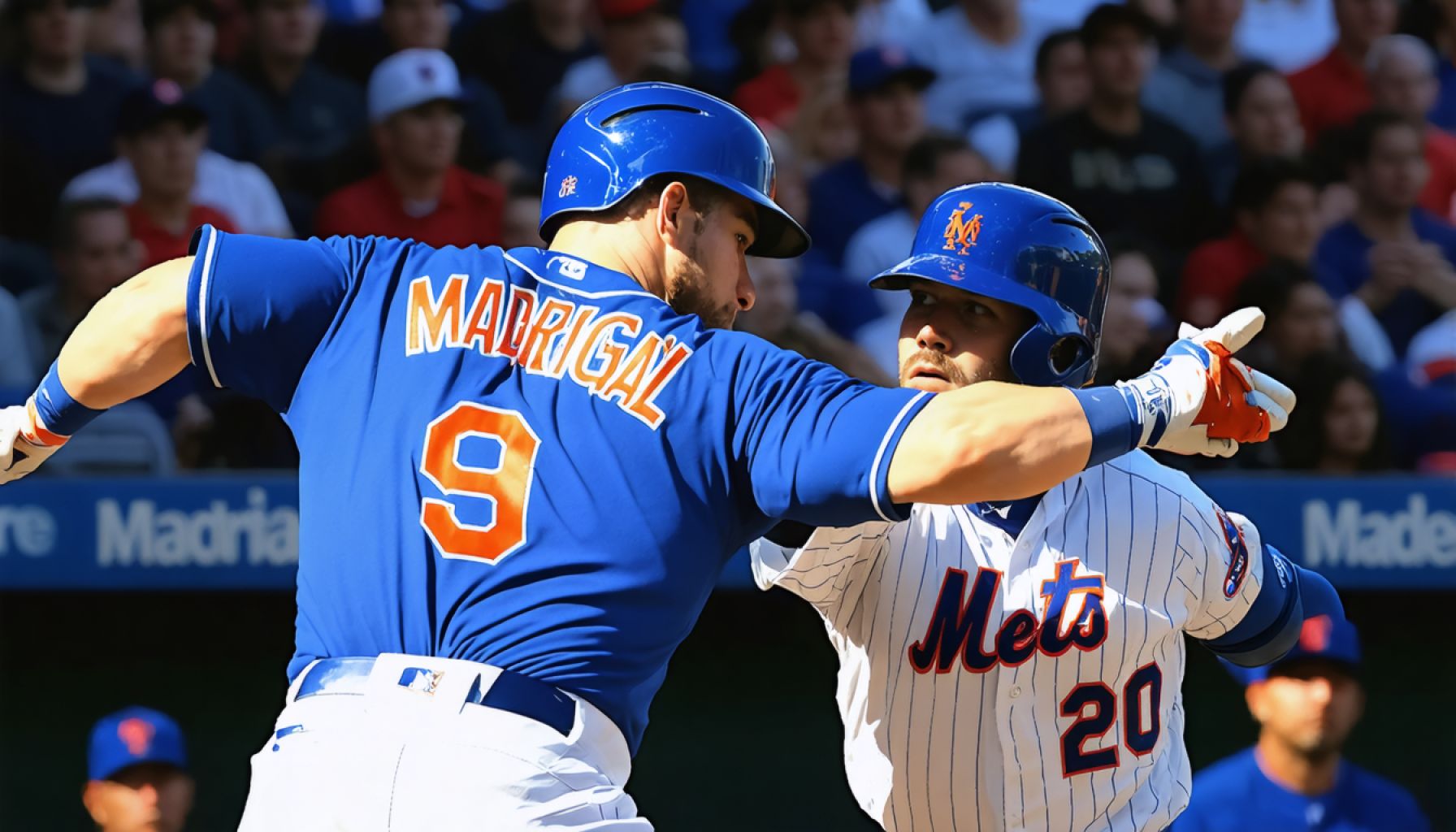- Nick Madrigal, an infielder for the New York Mets, suffered a shoulder dislocation during a spring training game against the Washington Nationals.
- This injury poses a significant challenge to Madrigal’s aspirations for securing a spot on the Mets’ roster this season.
- Madrigal, a 27-year-old seasoned player, joined the Mets in January after playing for the White Sox and Cubs.
- An MRI is pending to assess the extent of the injury, as fans and team members await the outcome with anticipation.
- The incident highlights the fragile line between triumph and setback, emphasizing the need for resilience in sports.
- Madrigal’s journey underscores the importance of perseverance in overcoming challenges and striving for success.
On a crisp Florida afternoon, fans watched with bated breath as New York Mets’ infielder Nick Madrigal, a determined figure on the field, charged an elusive grounder, his eyes locked on the prize. The moment crackled with intensity, but as he fired the ball to first base, a brutal twist of fate ensued. Madrigal tumbled onto the lush grass, his face a canvas of pain, clutching his left shoulder.
This unexpected shoulder dislocation during a spring training game against the Washington Nationals casts a shadow over Madrigal’s season ambitions. It’s a critical juncture for the 27-year-old, who finds himself in the pressure cooker, vying for a coveted spot on the Mets’ roster. Having already passed through the gauntlet of MLB teams, from the White Sox to the Cubs, Madrigal hoped to pen a new chapter with the Mets after joining them in January.
The upcoming MRI looms large, as everyone, from coaches to fans, waits with the patience of cats stalking prey, eager to learn the fate of the talented infielder’s spring prospects. Madrigal’s career journey—a fourth-overall pick turned seasoned player—is rife with challenges, yet punctuated by resilience.
As one watches the story unfold, a reminder echoes through the world of sports: the line between triumph and setback is razor-thin, and the journey to the top demands every ounce of perseverance one can muster. In these fleeting moments of sport, resilience and recovery can define destiny, offering hope that, like Madrigal, we too can rise from the grass and chase our dreams anew.
Nick Madrigal’s Injury: What It Means for His Career and the Mets’ Season
How-To Steps & Life Hacks: Dealing with Shoulder Dislocation in Athletes
1. Immediate Response: Apply ice to the shoulder to reduce swelling and immobilize the joint with a sling.
2. Medical Attention: Seek emergency medical evaluation for a possible reduction procedure to reinsert the shoulder into the socket safely.
3. Rehabilitation Plan: Engage in physical therapy under professional guidance, focusing on strengthening shoulder muscles and improving flexibility. Begin with gentle exercises and progressively increase intensity.
4. Maintenance: Maintain shoulder stability with regular strength training, focusing on the rotator cuff and surrounding muscles to prevent future dislocations.
Real-World Use Cases: Impact on the Team
Nick Madrigal’s injury affects not only his career prospects but also the dynamics of the New York Mets’ infield. Losing a key player at second base might prompt the Mets to reassess their roster strategies. This situation could open opportunities for younger players to prove themselves during the season’s changeover.
Market Forecasts & Industry Trends: Athlete Health Tech
The sports industry’s growing focus on player health and technology-driven recovery solutions shows a promising trend. Wearables and tracking systems designed to monitor physical strain and predict injuries are expected to increase in use, providing athletes with customized rehabilitation strategies. Such technologies enable faster, more efficient recovery processes, crucial for players like Madrigal to return to peak performance.
Reviews & Comparisons: Medical Advances in Sports Medicine
Advancements in arthroscopic surgery and minimally invasive techniques have revolutionized injury recovery, reducing downtimes and improving outcomes for athletes. When compared to traditional approaches, modern rehabilitation plans are more focused, incorporating tailored exercises alongside therapies that expedite healing.
Controversies & Limitations: Risks of Early Return
One notable controversy in sports medicine is the pressure on athletes to return to play prematurely, risking re-injury or long-term damage. This underlines the critical balance between recovery and performance demands, an ongoing debate among athletes, teams, and medical professionals.
Features, Specs & Pricing: Sports Medicine Equipment
High-quality sports medicine equipment, ranging from resistance bands to advanced physiotherapy tools, supports effective rehabilitation. Costs can vary, but investing in reliable materials correlates with better recovery outcomes.
Security & Sustainability: Ethical Concerns in Sports Rehabilitation
As the demand for cutting-edge rehabilitation grows, ethical considerations around accessibility and affordability arise. Ensuring that all athletes, regardless of their level, benefit from top-tier medical support remains a challenge for the industry.
Insights & Predictions: Looking Ahead
Nick Madrigal’s resilience, demonstrated by his career trajectory, suggests he will likely approach his recovery with determination. If successful, this injury could transform into a pivotal moment, reshaping both his career path and the Mets’ season lineup.
Tutorials & Compatibility: Preventative Measures
Athletes can take preventative measures to avoid injuries like shoulder dislocation by incorporating stability exercises and ensuring adequate rest periods between intensive training sessions. Engaging in cross-training activities can also enhance overall muscular resilience.
Pros & Cons Overview: The Double-Edged Sword of Athletic Career
Pros:
– Enhances mental toughness and resilience.
– Provides a platform for showcasing skill and talent.
– Offers financial and personal growth opportunities.
Cons:
– High risk of injury and long-term health issues.
– Pressure and stress from competition and performance expectations.
– Unpredictable career duration due to possible injuries.
Recommendations and Tips to Apply Immediately
– For Athletes: Focus on holistic training regimes that include strength, flexibility, and mental conditioning.
– For Coaches: Prioritize player health by monitoring workload and providing adequate recovery time.
– For Fans: Support players during recovery phases and understand the pressures they face.
For more insights into sports medicine and athlete recovery, visit WebMD.
